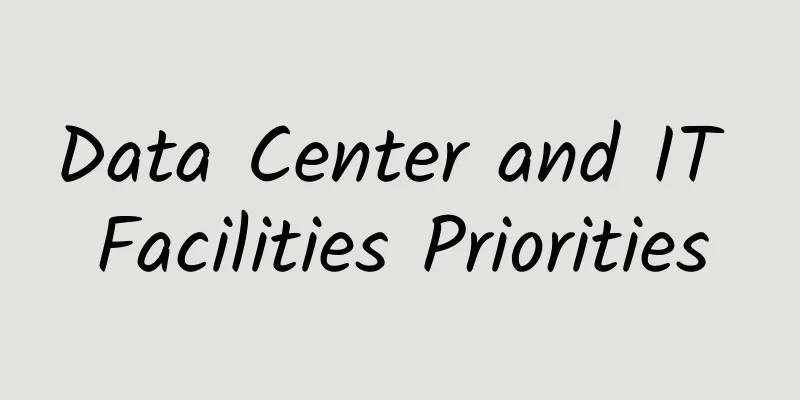Data Center and IT Facilities Priorities

|
Today, businesses undergoing digital transformation require the ability to support growing data volumes and data rates. Therefore, for future-proof data centers, data center and IT facilities teams need the right technology that fits into a sustainable investment strategy. A major trend that began in 2018 is the growing demand and investment by enterprises and organizations for centralized cloud computing data center services as well as edge data centers. The technologies developed by the hyperscale cloud giants are now migrating into the enterprise, where distributed applications dominate. The pressure on networks to perform is greater than ever before, and new technologies are beginning to be deployed to ensure that the network does not become a bottleneck for cloud computing.
Competitive Advantage Likewise, today’s digital economy businesses are deploying more computing, networking, and storage resources in edge data centers close to end users to provide fast and seamless access to critical applications and data. These edge data centers help optimize the response times that users of e-commerce and cloud-based applications expect. Edge computing is driving efficient bandwidth utilization and minimizing network connections and physical reach, which introduces latency into the infrastructure. Along with other areas of data growth, edge computing applications will generate petabytes of data per day by 2020. Systems that intelligently process data to create business advantage are critical to customers' future prosperity. Agile digital organizations rely on efficient data centers based on simplified design and flexible infrastructure platforms. We are witnessing more automation, more integrated solutions and software-defined functions that are reducing reliance on siloed systems. This allows users to take advantage of highly flexible infrastructure to increase capacity, monitoring and analysis, and improve data center efficiency. In this context, IT and facilities teams face the responsibility and challenge of deploying a data center that fully meets all their needs, whether on-site or in a co-located facility. The advent of 5G mobility and the proliferation of endpoints, the maturity of cloud computing and the increasing presence of edge data centers have put a spotlight on the network as a primary driver for improving data center performance and scalability. Priorities and solutions To manage changing requirements, network teams must work closely with other business units. It is no longer a question of hardware or software, but rather providing services that meet business needs. For IT and facilities teams, challenges range from designing, procuring and implementing the right IT and facilities to controlling costs and saving energy. Today, the typical multi-vendor, piecemeal approach forces data center operators to focus on costly integration to ensure interoperability. They need to consider issues such as support, management, operational inefficiencies and the increased likelihood of service level agreement (SLA) failures. Additionally, data centers must be purpose-built based on the organization’s business direction and long-term growth projections. The pressure to maintain rapid and efficient scalability places increasing pressure on IT and facilities teams to meet capacity demands or migrate to higher data speeds. End-to-end data center solutions that can interoperate will simplify the process of physical infrastructure design, specification, installation and management. These solutions optimize the data center to meet current and future needs. They also promote faster implementation, allowing IT and facilities stakeholders to stay ahead of demand. It will also minimize risk, required resources, and total cost of ownership through the following capabilities: 1. Converged infrastructure that changes with business needs The scalable architecture can meet changing business needs while reducing total cost of ownership and optimizing IT investment. For example, it provides accelerated design and seamless implementation to introduce new 40G/100G networks into traditional facilities. 2. High-speed connection As data center convergence grows, the adoption of high-speed data transmission fiber and copper cable systems can reduce the pressure on physical infrastructure. They increase network throughput, reduce latency, and improve agility, scalability, and return on investment (ROI) to support new applications such as the Internet of Things. 3. Cooling optimization By providing comprehensive visibility and control through real-time monitoring, organizations can be provided with actionable information that can reduce cooling energy consumption by up to 50%. 4. Basis for meeting service level agreements (SLAs), timelines and budgets Efficient and reliable infrastructure, including cable management, routing, security, grounding and bonding and identification systems, enables data center managers to better meet service level agreements (SLAs) and deliver projects on time. 5. Reduce visibility into business and technical risks Data center infrastructure management solutions provide a holistic view of the physical infrastructure, including real-time data on the power, cooling, connectivity, security and environmental status of individual devices from the enterprise to the data center cabinet. 6. Reliable infrastructure increases income Innovative physical infrastructure enables colocation providers to build a better data center experience for tenants. Highly flexible, scalable, and quickly installed infrastructure speeds onboarding and increases revenue. As IT and facilities teams consider data center priorities in 2019, it’s important to note the importance of designing and creating the most efficient and effective solutions to meet actual needs. |
<<: Life is not easy, where is the future for terminal manufacturers in the 5G era?
Recommend
2019 NXTWORK Juniper Networks Summit concluded successfully, Juniper Networks and China win together in the multi-cloud era
[51CTO.com original article] On July 11, 2019, Ju...
Network Basics: How IP and MAC Addresses Work
Both IP addresses and MAC addresses identify devi...
In the new era of medical IoT, Aruba builds the foundation of smart hospital network with three strategies
After making an appointment on the mobile phone A...
LRU implementation with expiration time
[[382833]] I saw this algorithm a long time ago w...
How will the Internet of Things impact future data centers?
The Internet of Things is more than just an explo...
Unlimited traffic ≠ unlimited traffic usage. Have you ever encountered this kind of "trap"?
"Use data nationwide as you wish", &quo...
my country's 5G construction and development have achieved remarkable results, and the 6G layout is about to start
At present, 5G, as a global emerging strategic in...
[11.11] Yecao Cloud: Hong Kong BGP network VPS annual payment starts from 83 yuan, Hong Kong international line annual payment starts from 79 yuan, Hong Kong independent server starts from 199 yuan/month
Yecao Cloud has brought this year's Double 11...
US telecom companies agree to delay 5G deployment
Recently, the U.S. aviation and telecommunication...
edgeNAT Double 12 VPS Hosting 30% off monthly payment and 40% off annual payment, Hong Kong/Korea/US data center
edgeNAT has released a Double 12 discount plan, v...
Tencent has already surpassed the three major operators in seconds, and it may be time to stop letting the fish grow
Since 2015, the regulatory authorities have vigor...
LinkRunner G2 is a favorite of operators and maintenance personnel! See how NETSCOUT creates the "measurement" in the network testing industry
[51CTO.com original article] In recent years, I h...
The original intention of building Huawei Software Development Cloud: to deliver excellent development methods and capabilities to software companies and developers
[51CTO.com original article] With the rapid devel...
Are operators “breaking away from” the old ways? 2G/3G networks will eventually leave the stage
Recently, China Telecom Yunnan Company (Yunnan Te...
5G new scenarios and technologies bring new security threats
Compared with the traditional mobile Internet sce...









